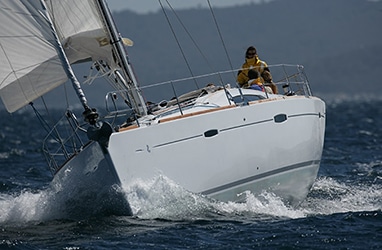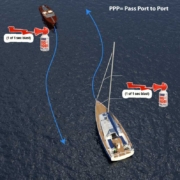Head-on Nav Rules Situation
The Rule
(a) Unless otherwise agreed when two power-driven vessels are meeting on reciprocal or nearly reciprocal courses so as to involve risk of collision each shall alter her course to starboard so that each shall pass on the port side of the other.
(c) When a vessel is in any doubt as to whether such a situation exists she shall assume that it does exist and act accordingly.
Discussion
The agreement above can be established via VHF, light, or sound signals. The vessels in a head-on situation will each turn to starboard allowing them to pass “Port to Port”. The audible announcement of this is 1 one second blast. The easy way to remember this is 3P’s: “Pass Port to Port”.
When two sailboats are under sail only and are approaching head-on the rule of opposite tacks is in effect. Sailboat on the port tack (wind coming from their port (left) side of their own boat) must giveway to the sailboat on starboard tack (wind coming from their starboard (right) side of their own boat).
What about a powerboat coming head-on to a sailboat? To fully answer this question, you’ll need to jump ahead to the page on Responsibility between Vessels. In general, powerboats must stay out of the way of sailboats but (there is a huge BUT) there are situations where sailboats must giveway. For now, in general, if the powerboat is a recreational powerboat then it must giveway to the sailboat under sail. But we are not saying that it will giveway.







